Are more UFC fights going to a decision?

Back in the humble and barbaric beginnings of the UFC, the octagon was a stage for violence with the elite of various disciplines battling it out to see which martial art was superior. With the lack of rules and individuality of skill sets, fighters were getting put to sleep for fun by absolute savages whether it be via brutal Mark Coleman ground-and-pound or ruthless Royce Gracie chokes.
For the integrity of the sport, the Unified Rules of Mixed Martial Arts were established which introduced a criteria for judging; more weight classes, gloves and general in-fight rules to essentially make the sport more humane.
This was the cornerstone in the evolution of MMA but it did not take away from the excitement of skilled athletes going toe-to-toe, with the majority of bouts still ending via a knockout or submission. However, over time it feels that more fights are ending in decisions. In fact, the majority of fights seem to be going to the bell.
The only way to find out is to analyse how every UFC fight has finished and it is a good excuse to discover any trends. I began collecting the data from 2001 at UFC 31 (when the new rules and weight classes were settled).
Before delving into the numbers, here are some important points to note:
- May 2001 (UFC 31) - weight classes were reformed into: Heavyweight (206-265 lbs), Light Heavyweight (186-205 lbs), Middleweight (171-185 lbs), Welterweight (156-170 lbs) and Lightweight (146-155 lbs)
- August 2004 to March 2006 - Lightweight division was suspended
- December 2010 (TUF 12 Finale) - Men’s Featherweight (145 lbs) and Bantamweight (135 lbs) divisions introduced after acquiring WEC
- March 2012 (UFC on FX 2) - Men’s Flyweight (125 lbs) division introduced
- February 2013 (UFC 157) - Women’s Bantamweight (135 lbs) division introduced
- December 2014 (TUF 20 Finale) - Women’s Strawweight (115 lbs) division introduced
- June 2016 (UFC Fight Night 89) - Women’s Flyweight (125 lbs) division introduced
- December 2017 (UFC 208) - Women’s Featherweight (145 lbs) division introduced
- Cris Cyborg had two fights at a catchweight of 140 lbs in 2016 against Leslie Smith and Lina Lansberg – these were grouped into the women’s featherweight stats
The chart below shows how every single UFC fight since UFC 31 finished as a percentage by year. As you can see, there is a clear downward trend of knockouts and submissions since the unified rules came in, meaning an increase in the amount of decisions.
UFC FINISHING STATS (SINCE 2001)
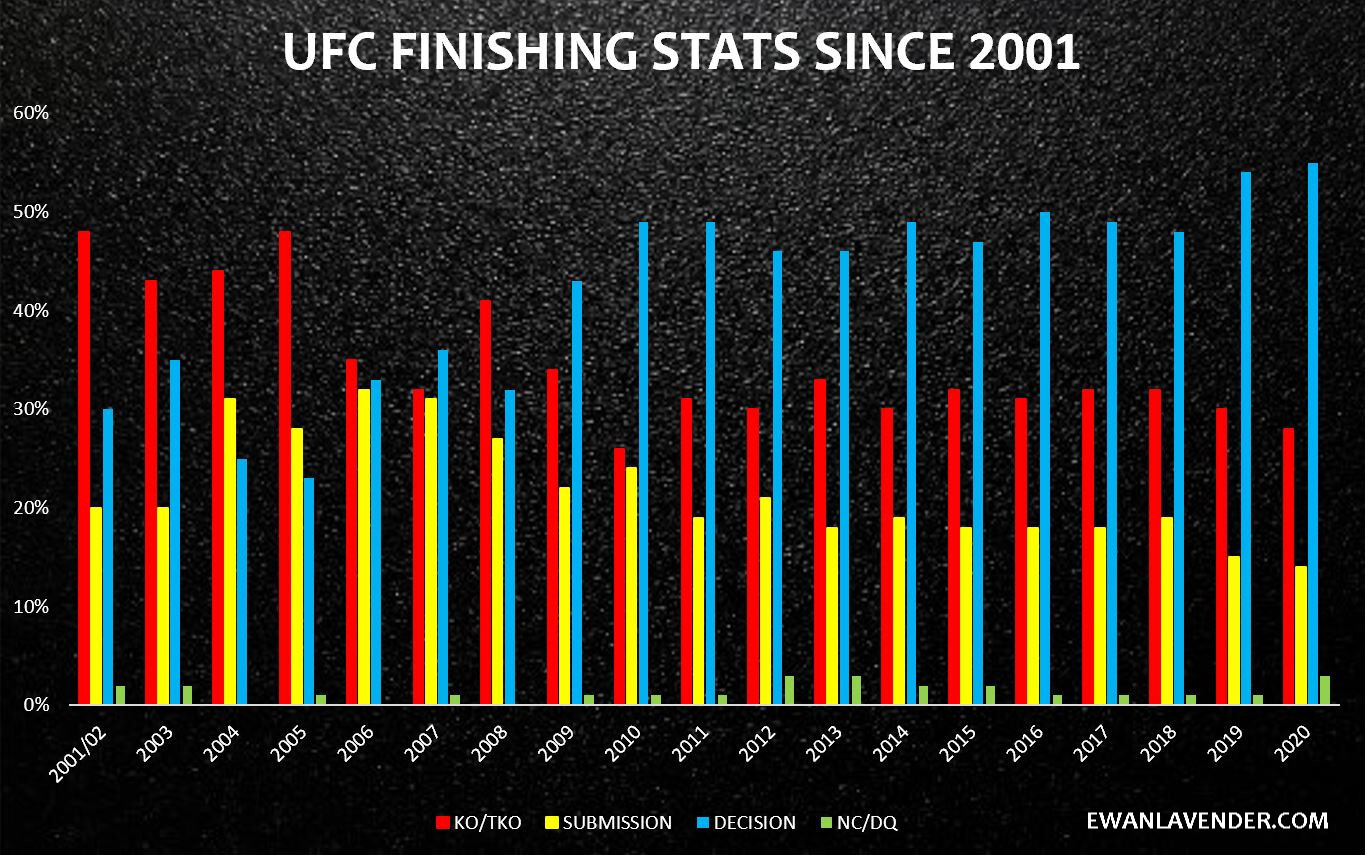
Below are the percentages of knockouts, submissions and decisions separated for a clearer depiction:
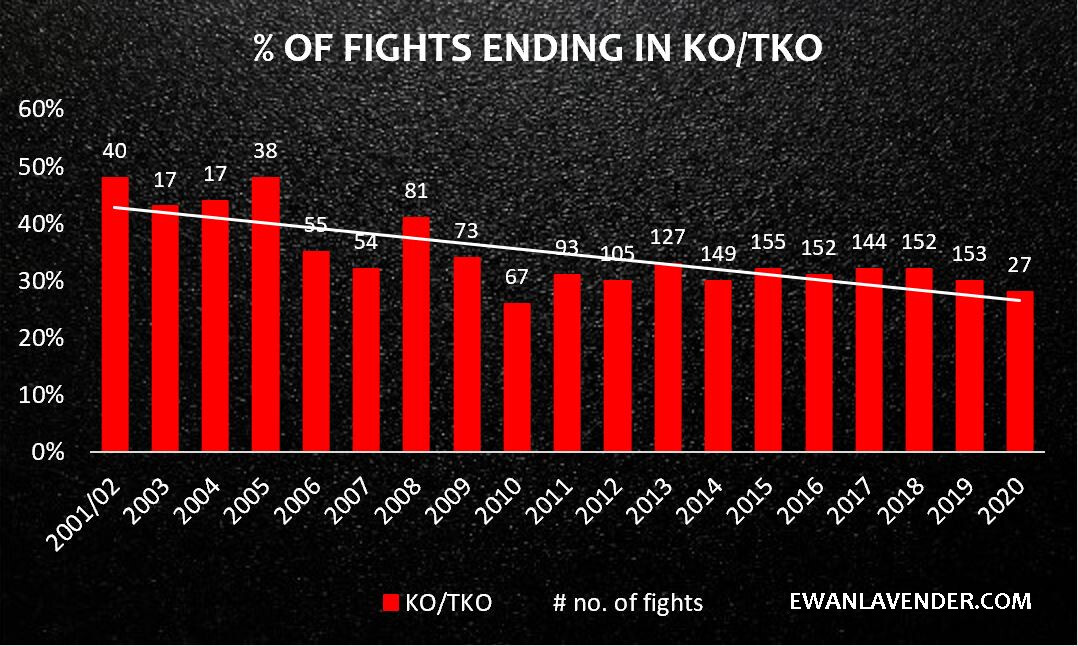
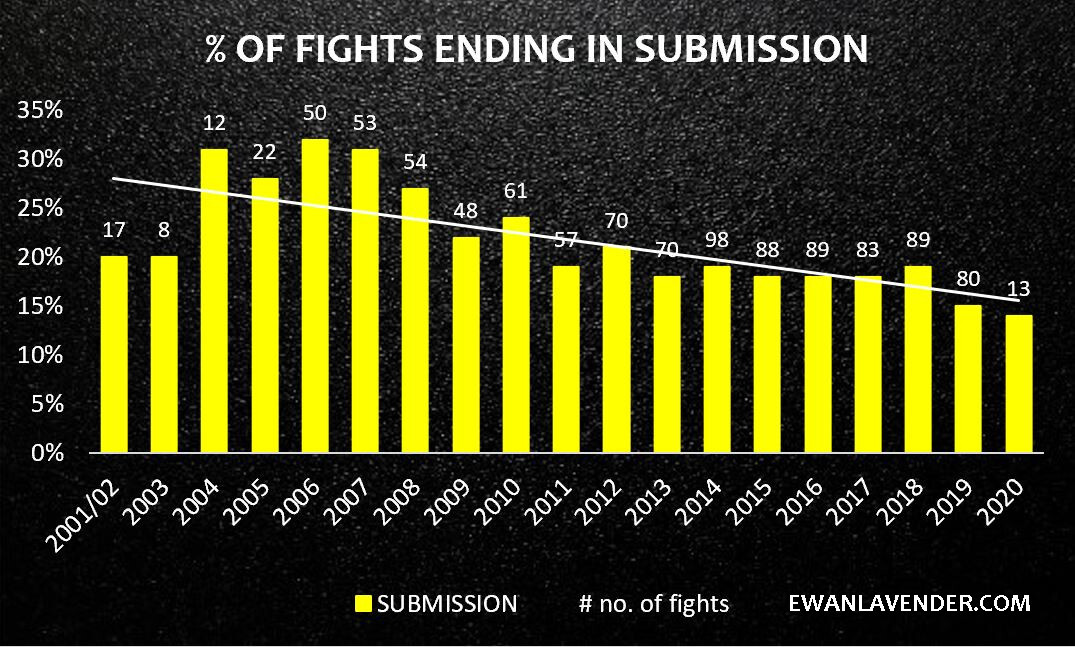
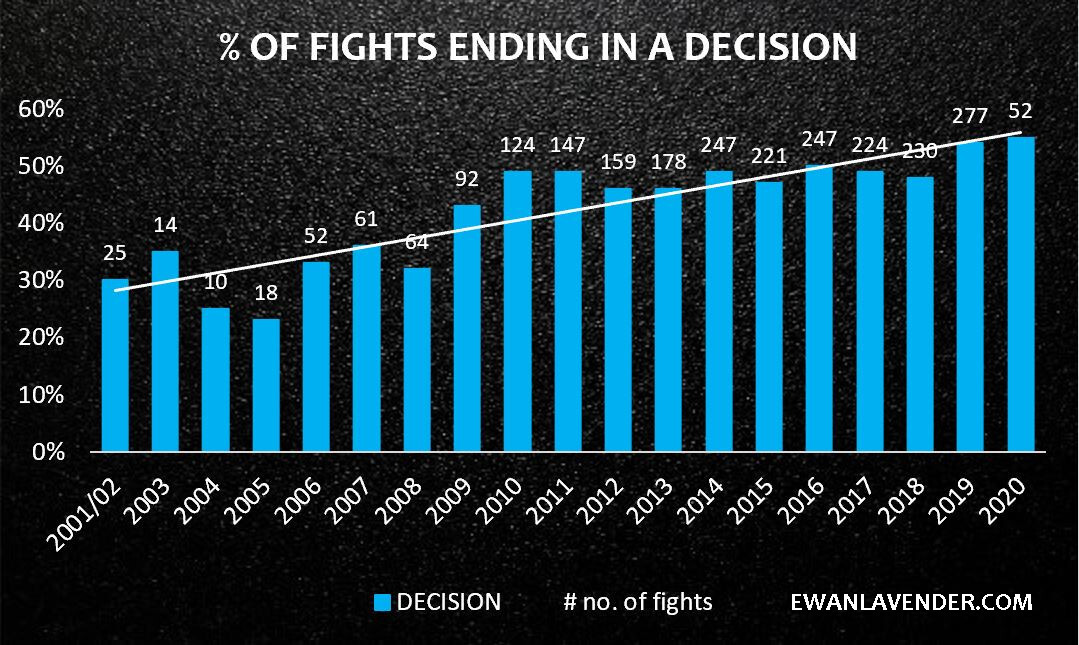
There are various reasons why less fights are getting finished, with the main reason being that fighters are simply getting better, in particular their defence. Back in the early days, people did not train for MMA. Instead, they mastered their own discipline and then added new skills to their game. Now, the new generation begin by training every important discipline, or they at least start to train various disciplines early in their career. For example, you get collegiate wrestlers adding Kickboxing and Brazilian Jiu-Jitsu to their game or Jiu-Jitsu practitioners adding Muay Thai to their game etc.
The offence of a fighter has always been exceptional and has steadily improved, but their defence has gone from sometimes non-existent to essential and is the main reason less fighters are getting knocked out or submitted. This is how Royce Gracie put Brazilian Jiu-Jitsu on the map. He was coming up against monster after monster, taking them down and wrapping up some sort of submission with ease. They did not know how defend against Jiu-Jitsu and if you do not know how to defend against Jiu-Jitsu today, you wouldn’t get anywhere near the octagon.
There are obviously other reasons such as the evolution of gyms, better coaches, more training partners and also the fact that as MMA has become a legitimate sport, it has become a profession so people can train full time and enhance their skills as well as their endurance to remain competitive for 15-25 minutes.
One of the biggest changes the UFC have made is the introduction of lighter weight classes throughout the years. These stats include 12 different divisions, so do different weight classes produce different finishing rates? Let’s take a closer look at each division:
FINISHING % OF EACH DIVISION (SINCE 2001)
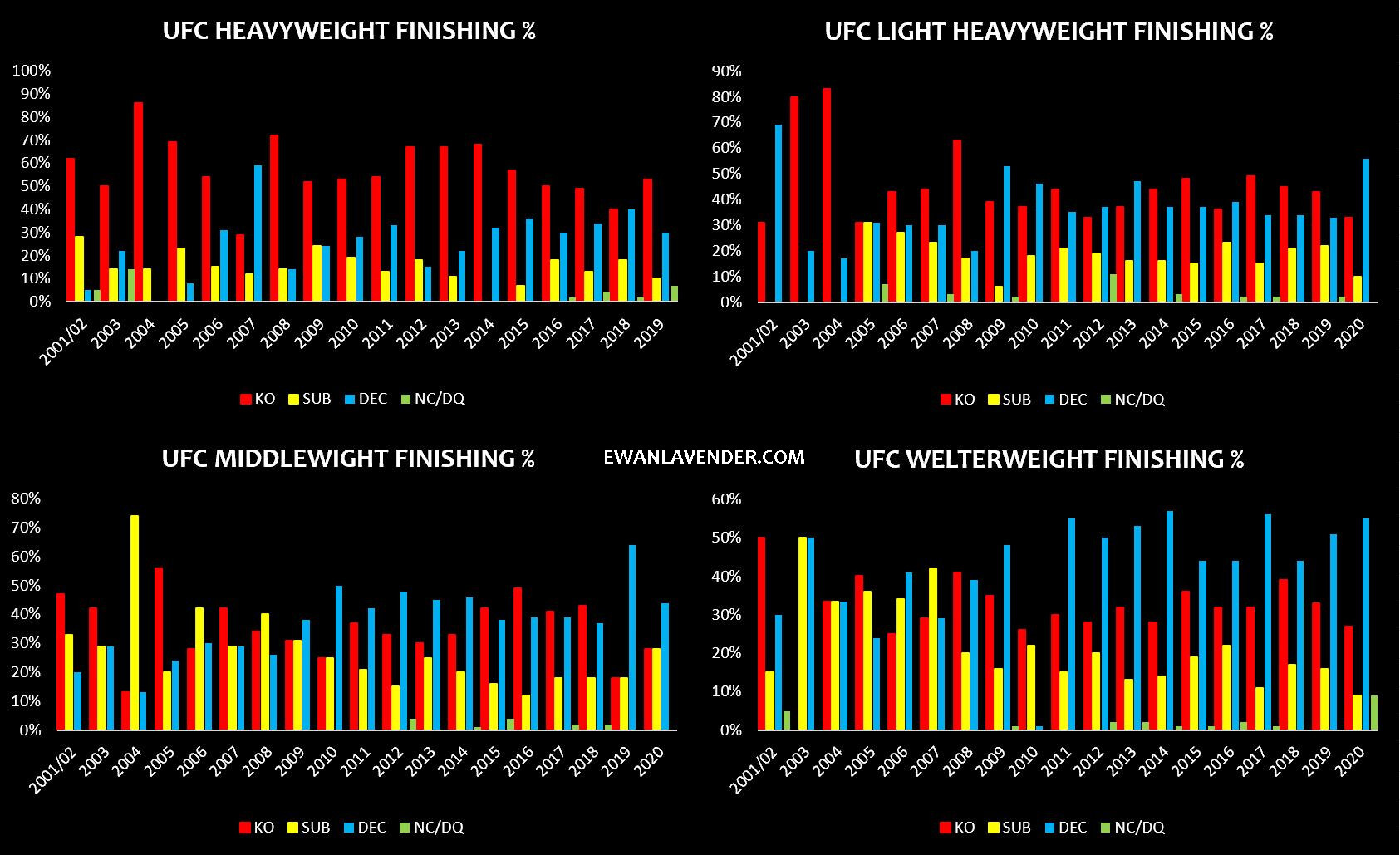
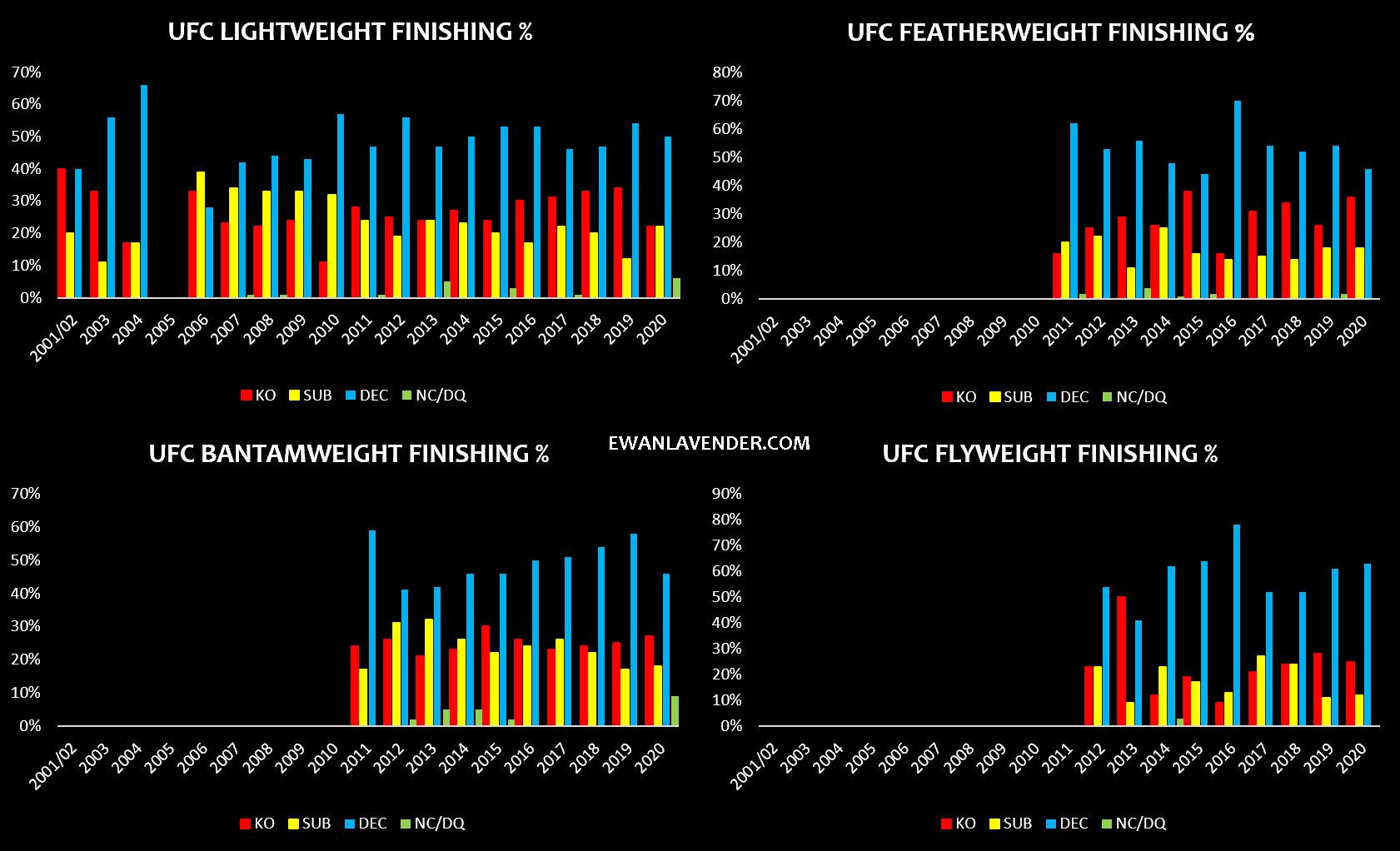
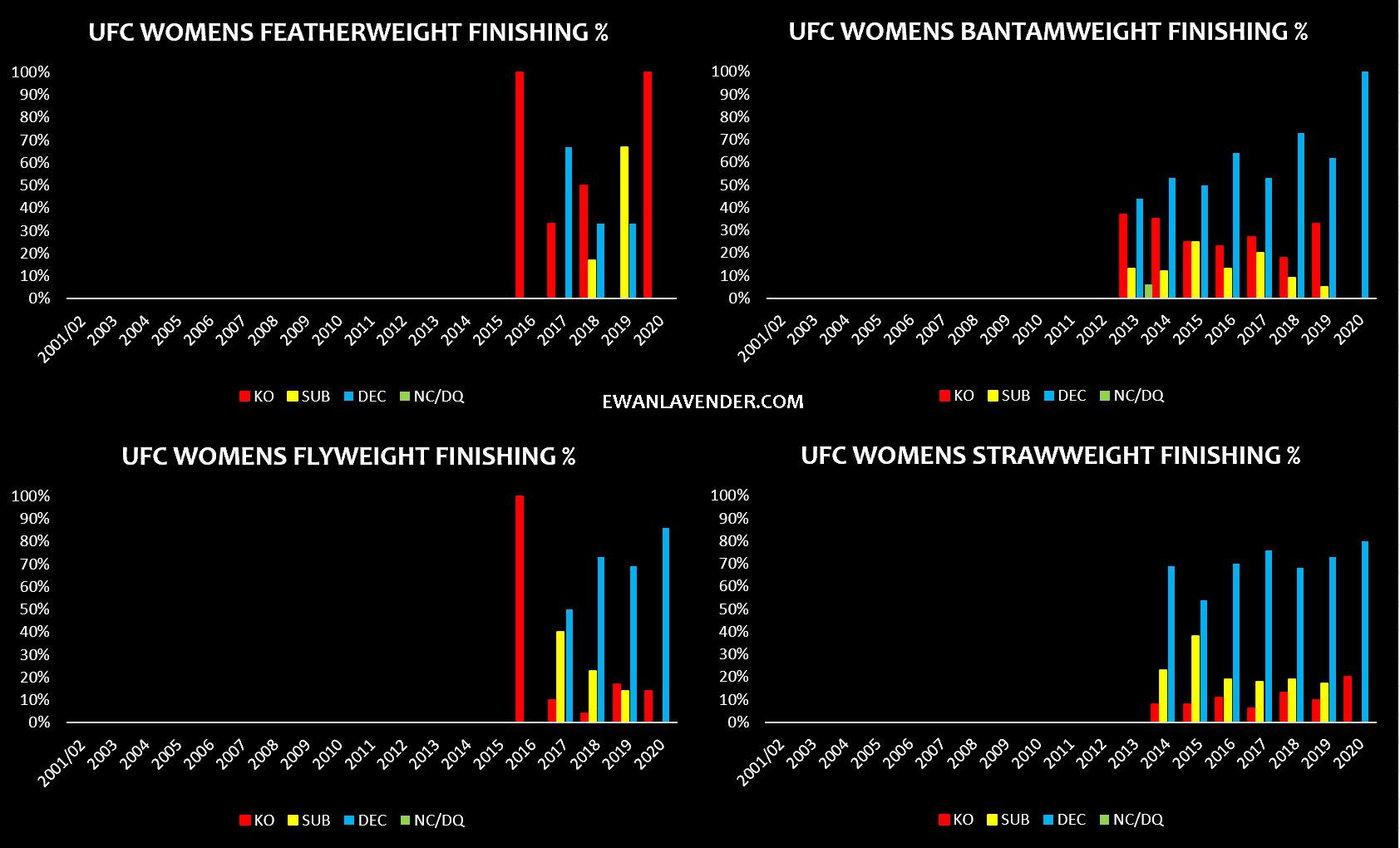
As you can see, the original hypothesis of less finishes as time goes on, generally runs through all of the weight classes. It is also interesting to see that the heavier the weight class, the higher the percentage of fights ending in a knockout, but an important factor is that the lighter the class, the more decisions there are, and that has affected the overall stats.
Although the amount of submissions has decreased for reasons already discussed, their percentages are relatively consistent throughout the divisions, which makes sense as they rely more on skill as opposed to raw power.
There are some large spikes in the early years, but it is important to note the sample size of each division. There were far fewer events early on and less fights in the lighter weight classes as they were established at later times, but in recent years there are more fights in the lighter divisions besides Flyweight. This is also important to consider with the female weight classes. There have been very few Featherweight fights compared to other divisions which will inflate certain stats. For more clarification, here is a table showing the amount of fights there were in each division by year:
NUMBER OF FIGHTS PER YEAR IN EACH DIVISION (SINCE 2001)
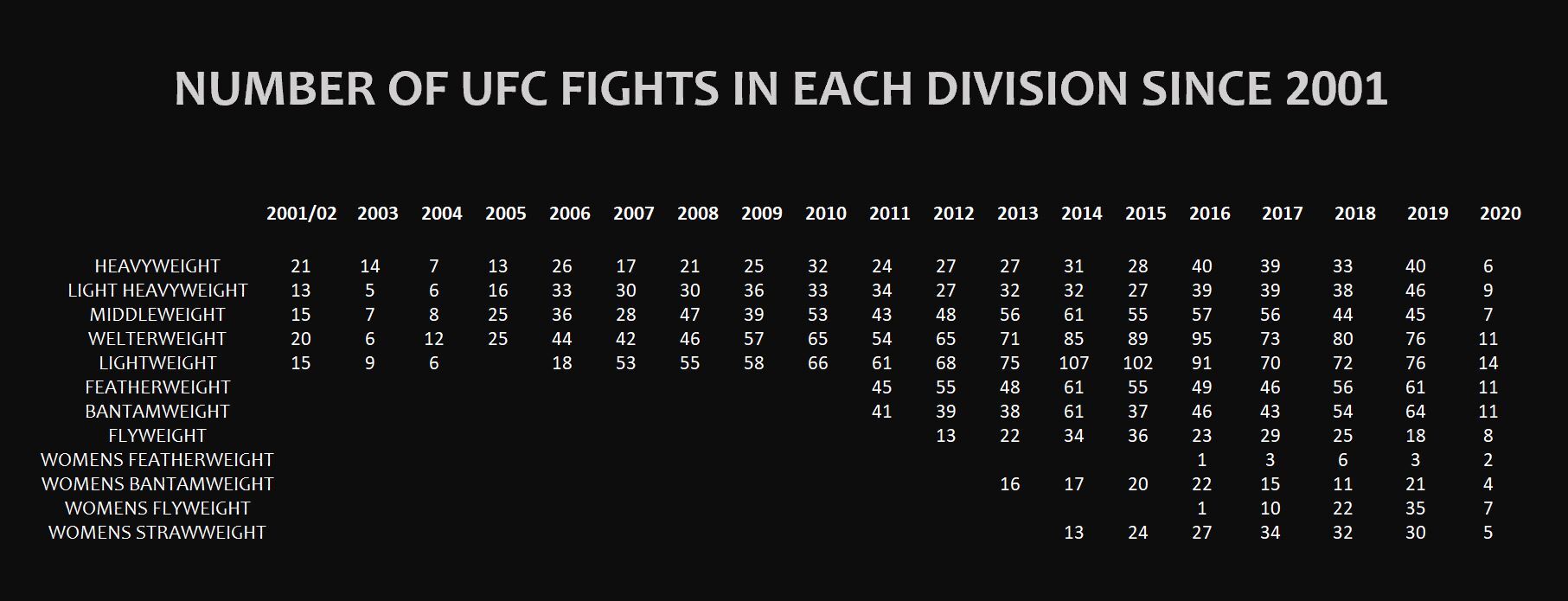
So, let’s see exactly how the divisions compare in terms of knockout, submission and decision percentages:
KO/TKO % IN EACH DIVISION (SINCE 2001)

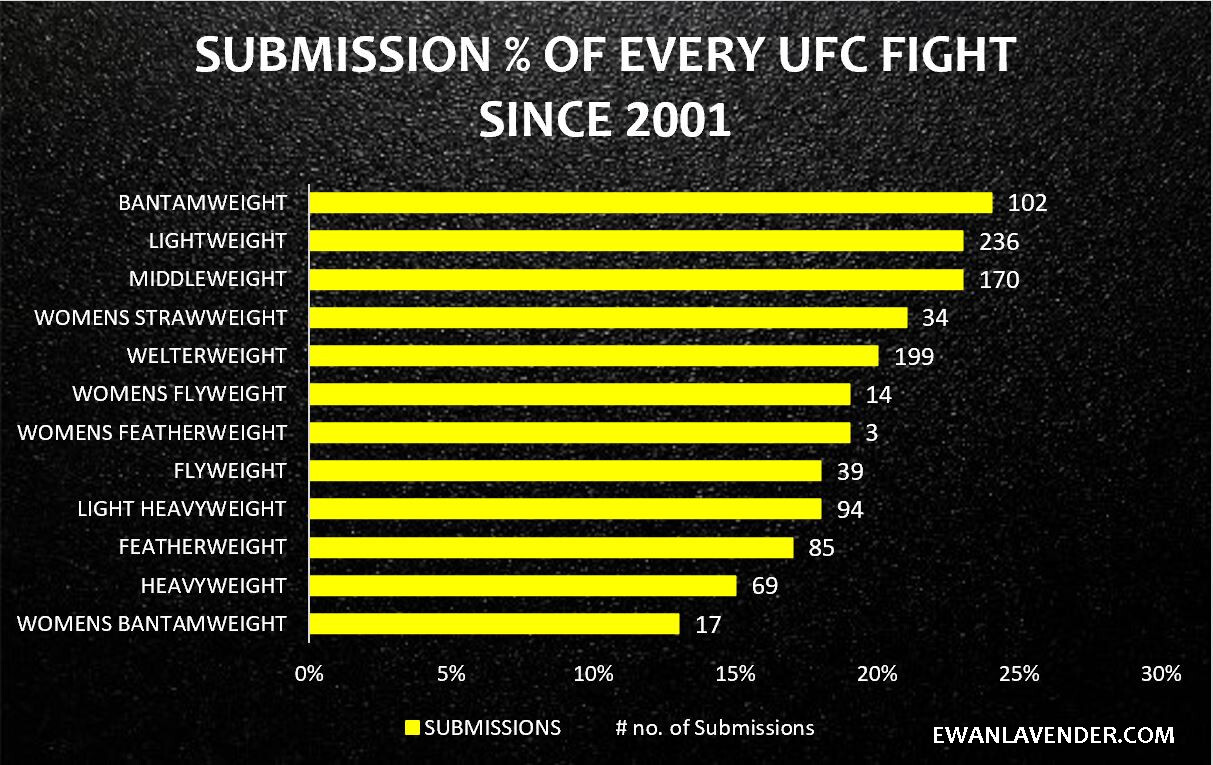

The knockout percentages show that the heavier weight classes produce a higher knockout percentage, with the exception of the women’s Featherweight division (where stats are inflated). When there are so little fights, it comes down to individuals such as Cris Cyborg who was involved in 5 out of the 8 knockouts in the division.
The same can be said for Bantamweight Ronda Rousey when she was active between (2013-2016), where every one of her UFC fights ended in a finish (5 knockouts and 3 submissions). Without her, the decision percentage would be a lot higher.
The submission percentage is also random in terms of where each division ranks, which again eludes to the fact that size and power are less important in Jiu-Jitsu.
The decision percentage follows the same trend of the knockout percentage. The lighter the weight class, the more likely the fight will end in a decision, so does that mean the lighter the fighter or less power, the less chance of a knockout?
FINISHING STATS IN TITLE FIGHTS (SINCE 2001)
I have analysed the overall finishing numbers and how each division compares. Can we expect the same trends to appear in title fights not including interim championship bouts?
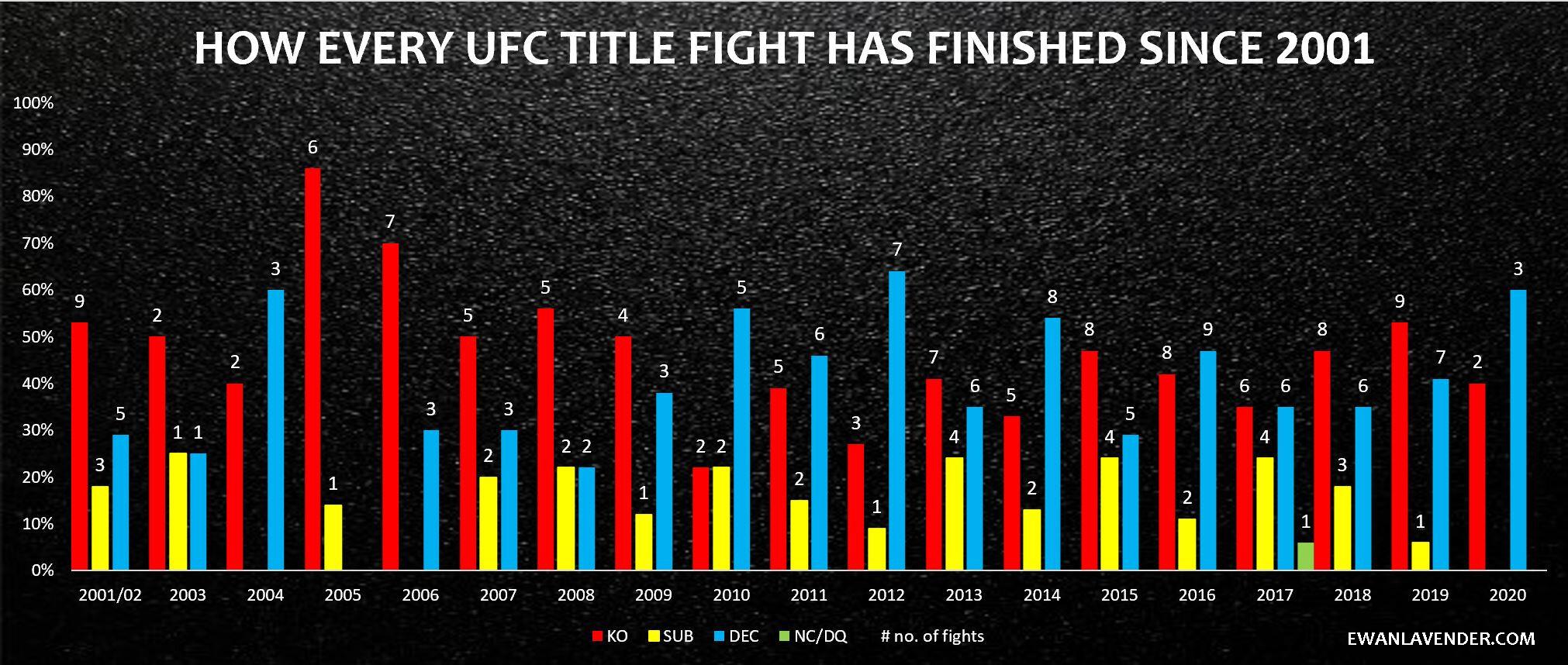
TITLE FIGHTS ENDING IN A KO/TKO (SINCE 2001)

TITLE FIGHTS ENDING IN A SUBMISSION (SINCE 2001)
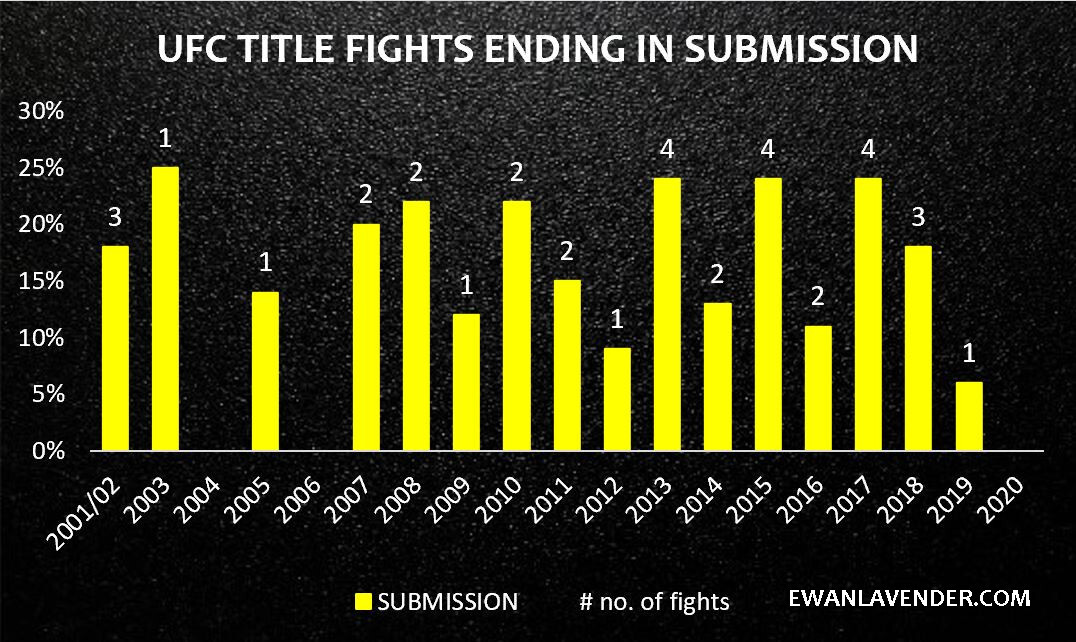
TITLE FIGHTS ENDING IN A DECISION (SINCE 2001)
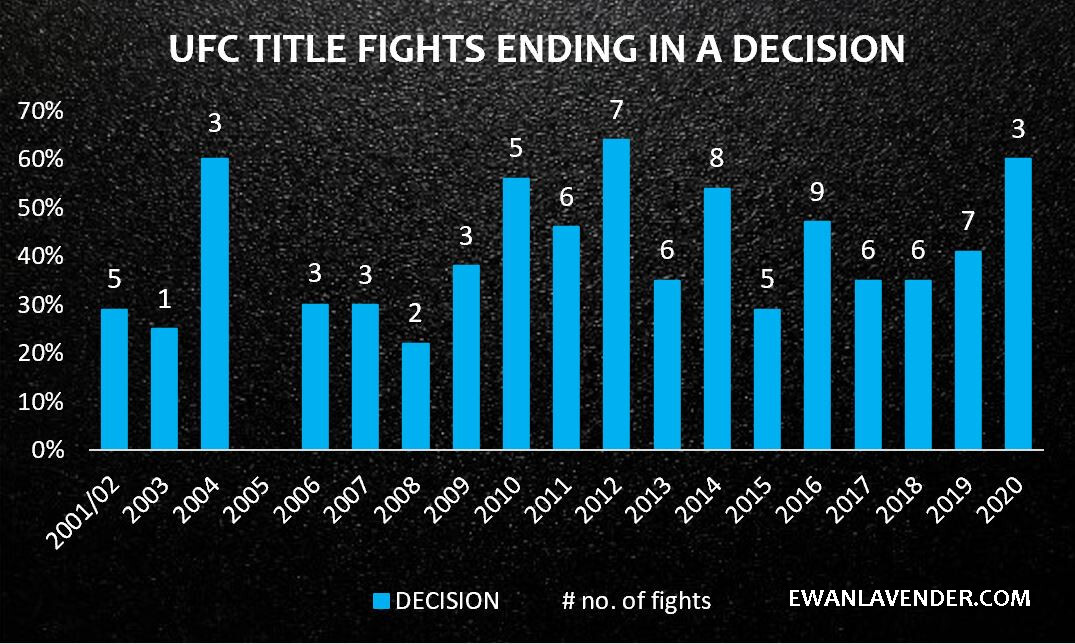
Interestingly, there appears to be no correlation and the results of title fights are completely random regardless of era and weight. Championship fights are all about individuals and stylistic match-ups.
For example, between 2007 and 2012 you had Anderson Silva dusting everyone until Chris Weidman caught his chin and then his shin bone. Between 2007 and 2013 you had Georges St-Pierre dominate but the division was so competitive that most of his fights ended in a decision.
In the Lightweight division, BJ Penn finished all his title fights but then he was dethroned by the decision king Frankie Edgar and then Benson Henson took over with more decisions. This comes down to their style but also how competitive the fights are.
Contrastingly, you can look at Ronda Rousey who was collecting arms and chins like groceries until she met Holly Holm and Amanda Nunes. Then, Nunes picked up where Rousey left off. Nunes, unlike most champions, is picking up more knockouts as time goes on.
So, bearing in mind the individual champions, let’s take a look how the divisions compare not including interim title fights:
FINISHING % IN TITLE FIGHTS (SINCE 2001)
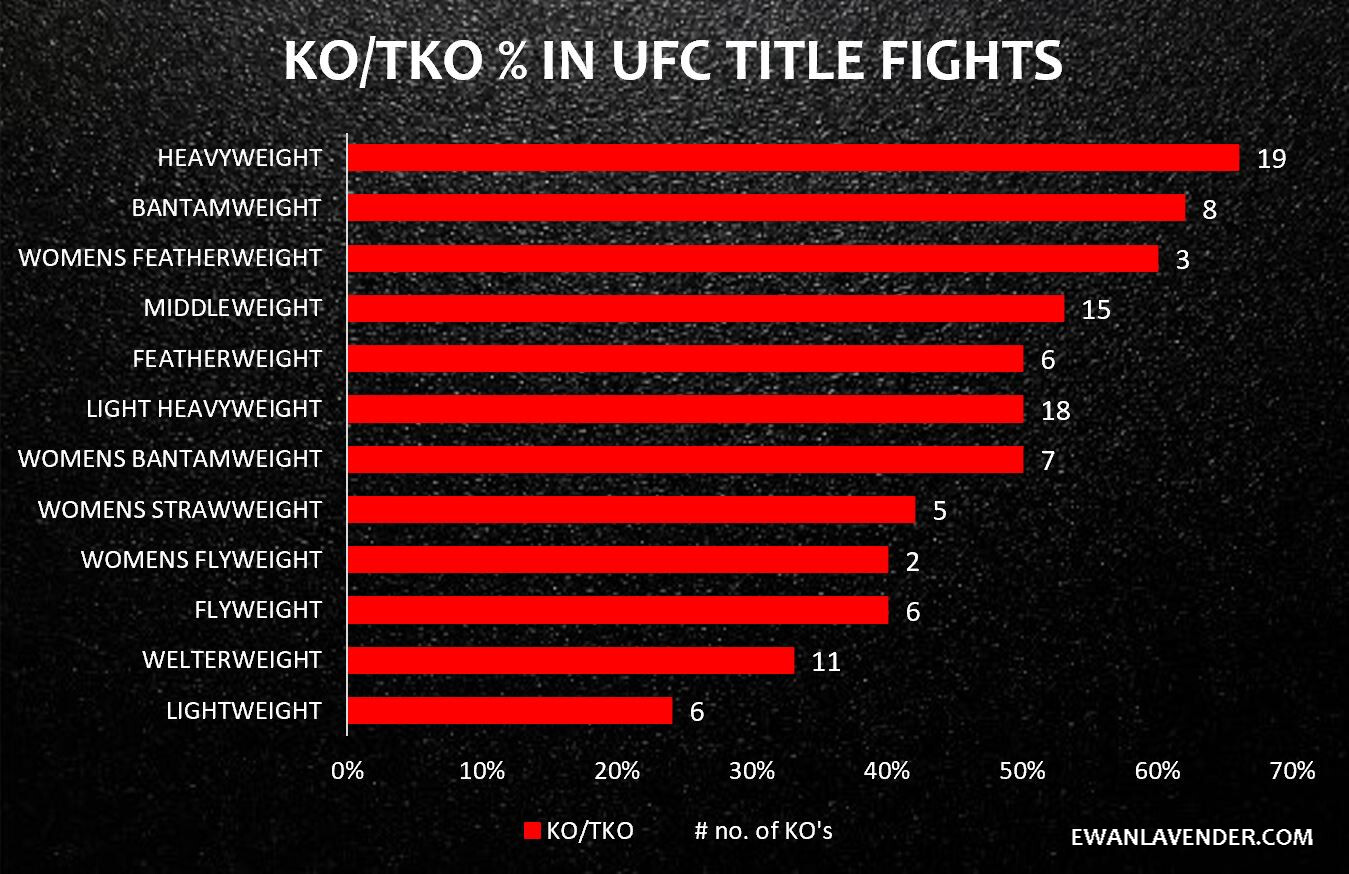
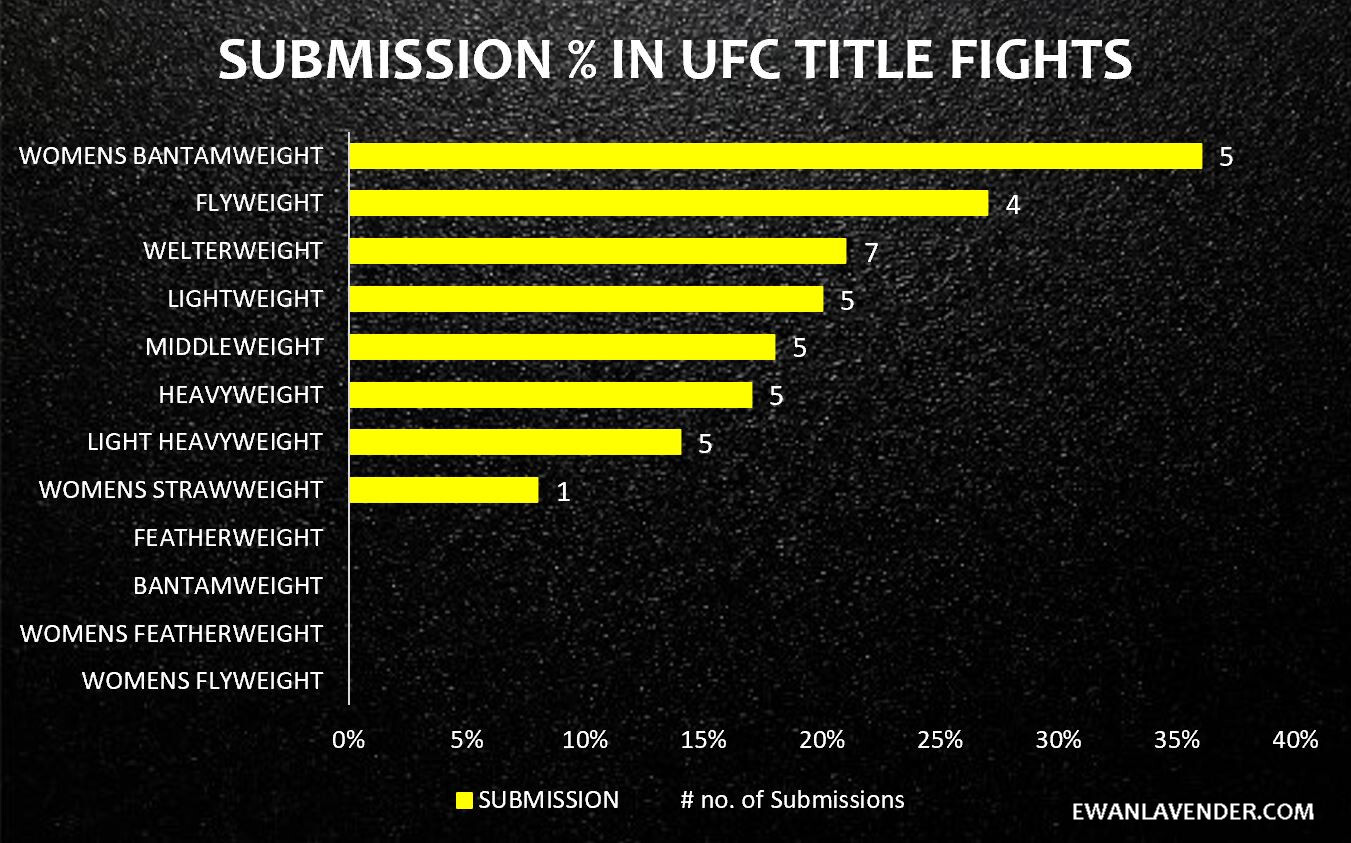
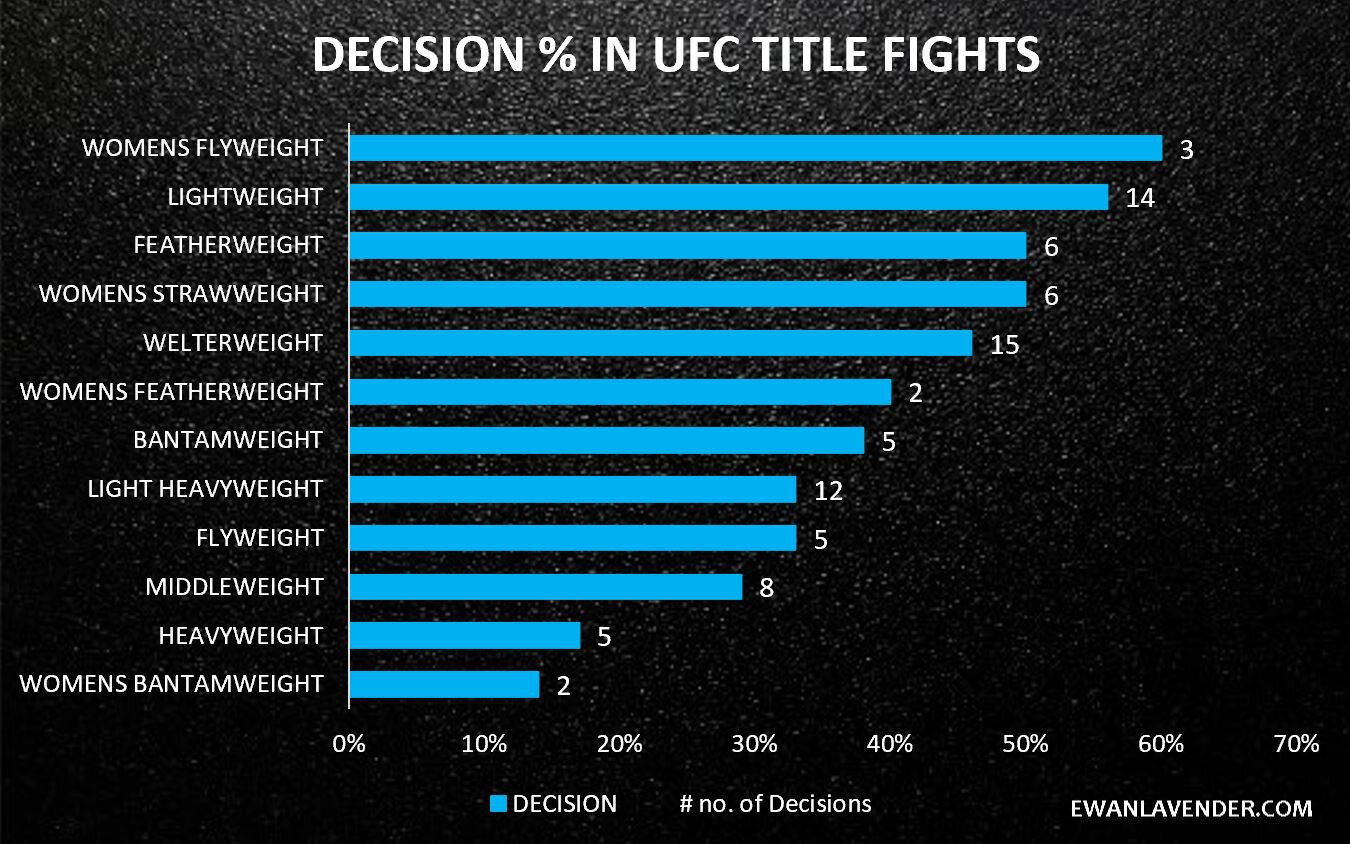
Unsurprisingly, women’s Bantamweight has the lowest decision percentage thanks to Rousey and Nunes, with contributions from Holly Holm and Miesha Tate. Welterweight and Lightweight also have the lowest knockout percentages mainly due to the competitiveness of the division but they are good representations as there have been 18 different champions (9 Welterweight and 9 Lightweight) in the divisions since 2001. Women’s Flyweight has the highest rate of decisions but there have only been 5 title fights in UFC history.
Heavyweight has the highest knockout percentage which is no surprise and interestingly Bantamweight has the second highest percentage with 62%. This rate is courtesy of Renan Barao and TJ Dillashaw, who claimed all of the knockouts (Barao 3 and Dillashaw 5). However, if Dominick Cruz stayed healthy and remained the champ, the percentage would be different.
The percentages for Flyweight are all due to Demetrious Johnson. He is a seamless fighter capable of all types of finish, plus he struggled to find any Flyweights on his level until Henry Cejudo pulled off a shock decision in 2018.
So, are there more or less finishes in title fights? Let’s take a look at how title fight finishes compare to the overall finishes in the UFC:
ALL FIGHTS VS TITLE FIGHTS: FINISHING % (SINCE 2001)
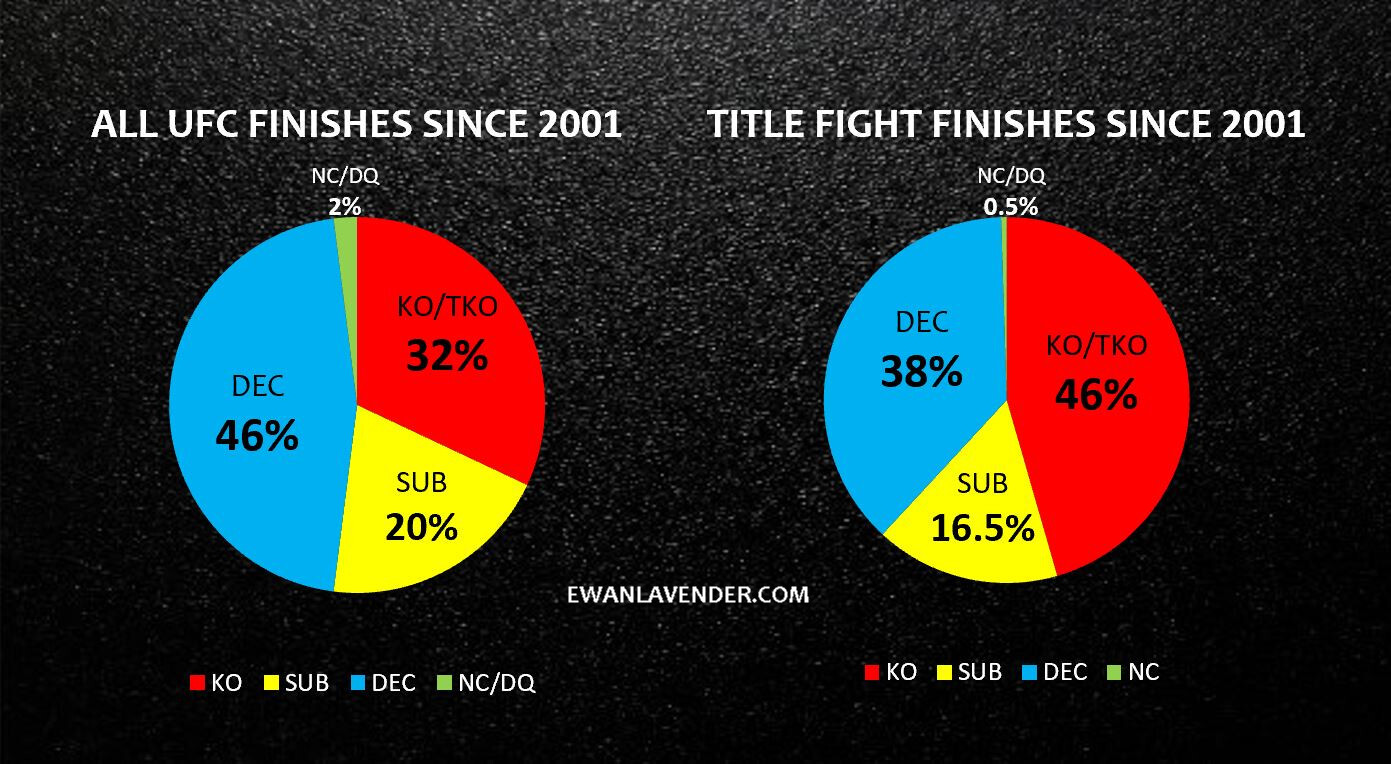
There are fewer submissions in title fights but there are more knockouts, which is great to see as there is nothing more hair raising than a highly anticipated title fight ending in a knockout.
MALE/FEMALE DIFFERENCES IN FINISHING % (SINCE 2001)
Looking at the overall percentages of finishes, here is a comparison between men and women:
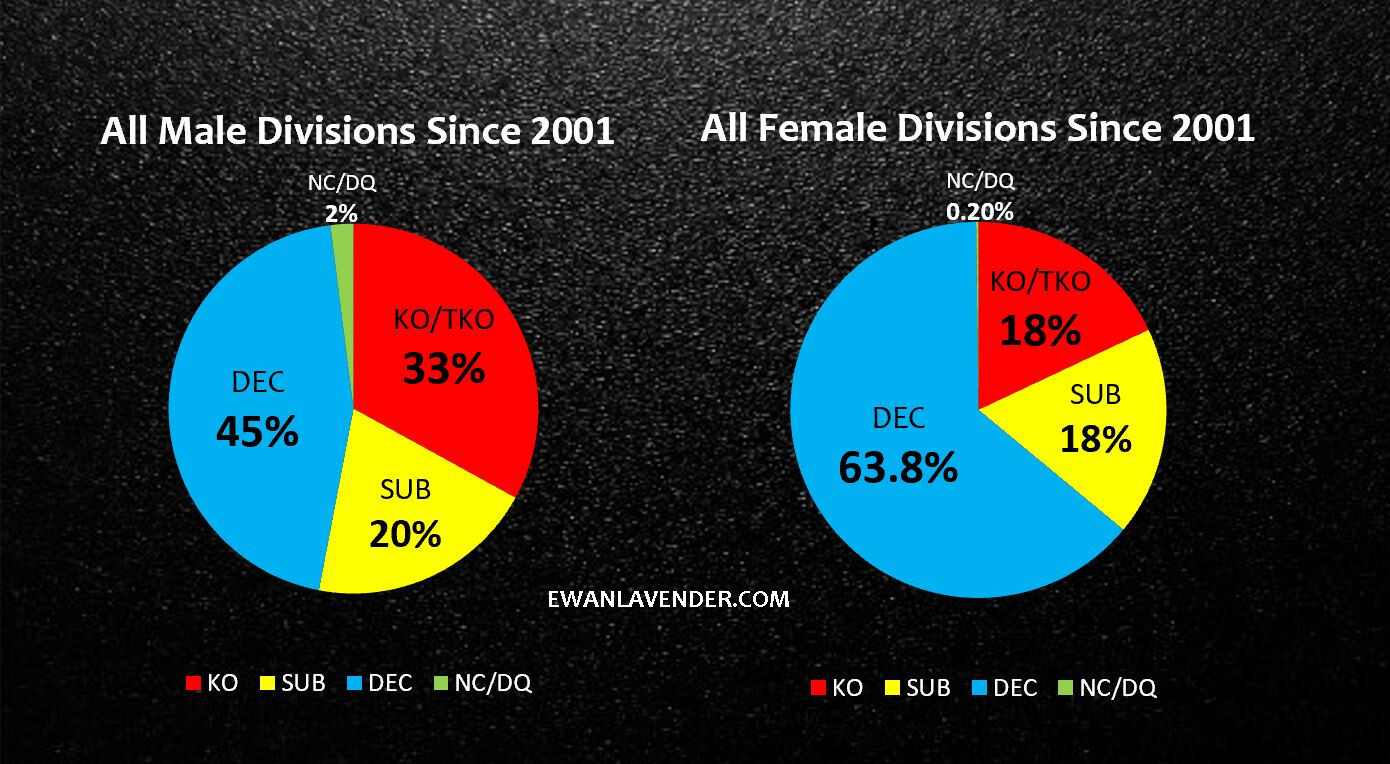
The rate of submissions are similar and there are a lot less knockouts in women's fights. This mainly comes down to the difference in power but there are five heavier male weight classes, so for a fairer comparison let’s breakdown the finishing of the men’s Featherweight, Bantamweight and Flyweight divisions:
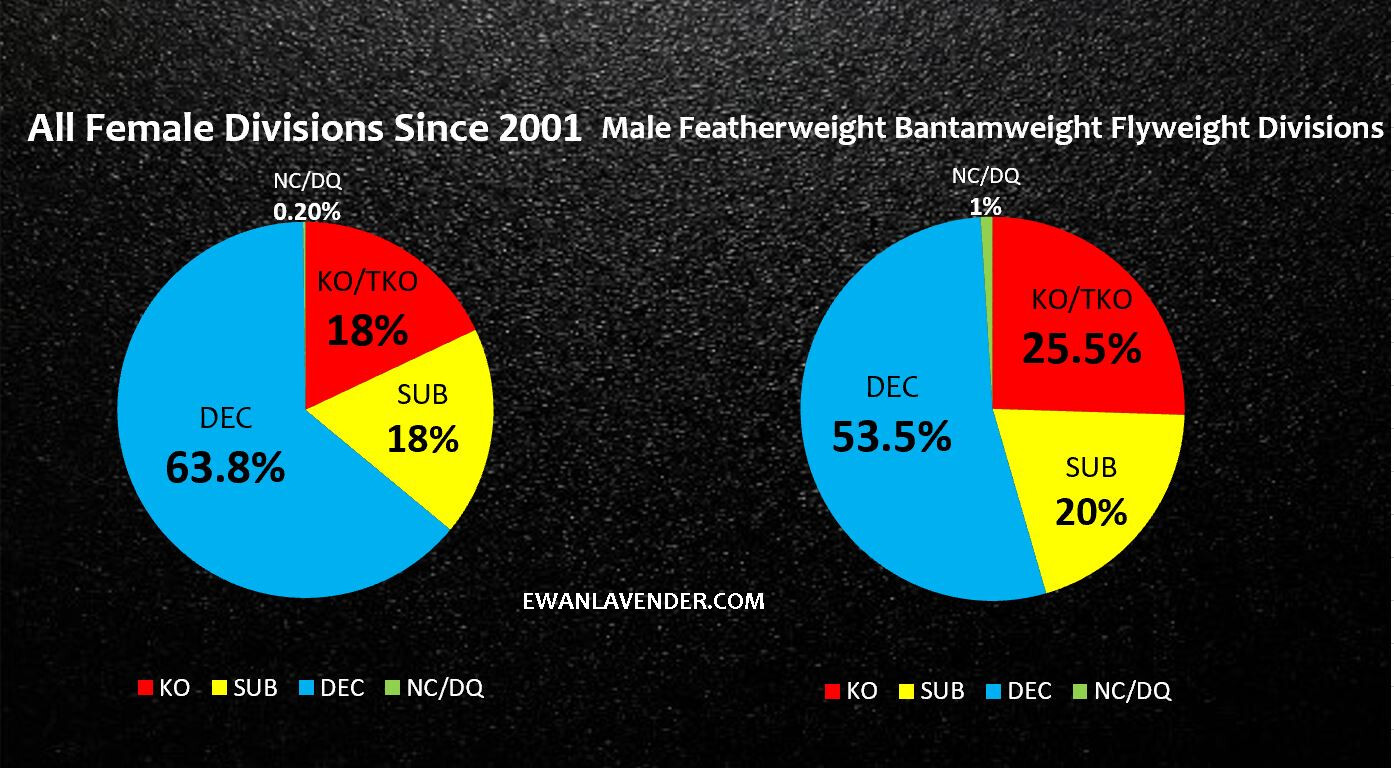
This still is not completely fair as there is no men’s Strawweight division and there have been a lot more male Featherweight and Bantamweight fights. That said, there is still a clear difference.
What are your thoughts?
Why do you think there are fewer finishes as time goes on?
Do you think this trend will continue or plateau?
Is it a worry for the entertainment factor of MMA in the future?







